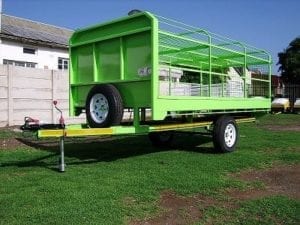The one-design-fits-all trailer is dead and buried.
Rather than mass produce, the trend nowadays is to design and build tailor-made trailers for the specific needs of customers. “Although our basic design commercial trailers still thrive in a healthy market, it happens more and more that customers ask for a custom design,” says Johnny van Rooyen of Johannesburg’s Trailrite Trailers. “We often complete custom-builds. In fact, we design and build as many commercial trailers as we sell standard products. Lately, we have been designing and building trailers for fleet maintenance companies for vocational use in local government. We’ve recently designed and built trailers to transport a large number of industrial lawnmowers.” Loadshedding has propelled innovation. “We were approached by a supplier of generators. His clients needed the generators to be more mobile, so he asked us to design trailers for his product offerings.” Van Rooyen says you need to be flexible to stay in the trailer game. “If you believe your product offering is the only one that customers would ever need, you are wrong. You need to listen to your customer and stay on top of developments. “An interesting request recently was from a service provider in the mining industry. We generally build trailers that are used as a means to transport goods from point A to B. But, for this client, we designed and built a trailer with a lighting setup that can extend very high and then fold up in a fairly compact space when it needs to be transported again.” Smart trailers Marius Kearney, sales and marketing director at Payloader Kearney, says his company’s philosophy now is to offer ‘intelligent’ trailer technologies to customers by providing solutions that are safer, offer lower costs per kilometre to the operator, have improved longevity, and boost productivity. He says customer-driven innovation is a cornerstone of its new approach. “We have developed a manufacturing process that uses the best design tools, materials and components available in the world market.” Kearney says, by using the best imported products available – from 3D-animation design tools to high-tensile steel, premium quality running gear and ancillary equipment – they are able to significantly push the payload envelope without compromising on build strength. Fit for purposeIt is important that a trailer be built for the purpose it will serve. “You need to plan around your tow vehicle. Your vehicle load capacity and needs must all be in proportion,” says Van Rooyen. “You can always upgrade later when your budget allows for a bigger tow vehicle, or just buy an extra trailer if you have another tow vehicle.
“The aerodynamics of a box-shaped trailer is important; not only for fuel economy, but it will also make the trailer more comfortable to tow due to less buffeting.” Kearney says they have a new range of interlink side tippers featuring a patented constant-velocity hydraulic tipping action that eliminates stresses, shock loads and stability issues during the tipping process. “This is the only side tipper of its kind in South Africa, and its merits are being proven in top fleets. It has a low height, and therefore a lower centre of gravity, making it the most stable side tipper on the market. “Technologies such as electronic braking system (EBS), roll-over prevention, electronic stability programme (ESP) and automated tyre inflation also boost overall vehicle safety,” he adds. “The constant-velocity 45-degree tipping action discharges product away from the vehicle in a smooth stroke, effectively improving vehicle longevity by reducing stress on the hydraulic rams, load bins and trailer chassis. The use of Domex steel and low-maintenance, European running gear has brought the trailer tare mass down significantly, allowing for a class-leading payload of 38.4 tonnes. With this new approach, Payloader assists the industry, by providing the necessary technology available, to create that safety net for trailers and meet customer demands in multiple operations. Weigh-in “Lowering trailer tare mass and total cost of ownership is the holy grail of trailer manufacturing,” says Kearney. “We have an exciting basket of products to really drive the industry forward in terms of safety, durability, overall cost-efficiency and payload productivity, because quality is long remembered after price is forgotten.” Although people may think steel is steel, says Van Rooyen, they have started using composite materials for specialised bodies on some of their trailers. “We have managed to save from 15% upwards of the total weight of the trailer. Although these materials are 10% more expensive than steel, it saves time, there is less welding needed and less distortion. Joining can be done with adhesives and this works especially well with event trailers.” As always, buyers should beware because some manufacturers do not fully comply with legislation. “Be very careful where you buy. It might seem cheaper initially, but there are reasons for paying less than what reliable and trustworthy manufacturers would charge for their products,” he cautions.







